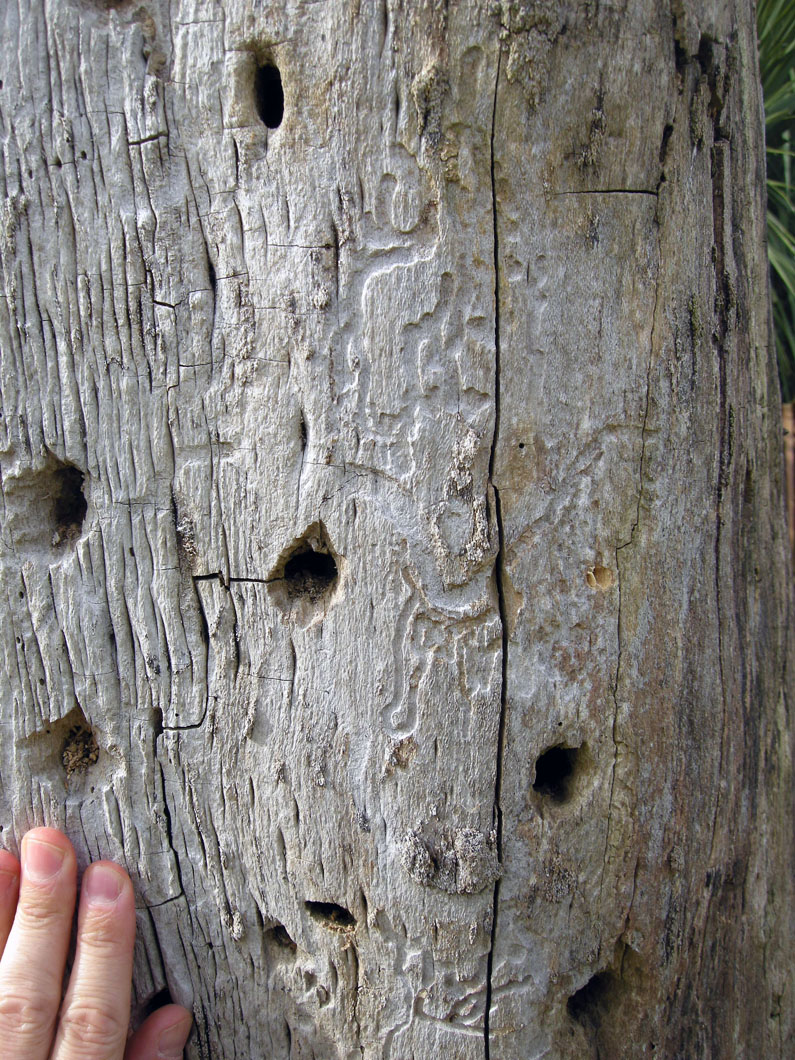Continuing the theme this week of celebrating the traces of the Georgia barrier islands, we this time move inland to the maritime forests, where a myriad of traces await us, most of them made by the true rulers of our planet, insects. In this instance, let’s focus on those insects that leave many well-defined and easily visible traces in so-called “dead” trees in those forests.
 A fortuitous exposure of insect tunnels bored into the wood of a “dead” pine tree (probably a loblolly, Pinus taeda). Most of these traces are probably from beetles, although other borings in any given tree could also be from carpenter ants, carpenter bees,and termites. And what made the big, deep holes? Just some insect-eating dinosaurs that some people insist on calling “woodpeckers.” (Photograph by Anthony Martin, taken on Sapelo Island, Georgia.)
A fortuitous exposure of insect tunnels bored into the wood of a “dead” pine tree (probably a loblolly, Pinus taeda). Most of these traces are probably from beetles, although other borings in any given tree could also be from carpenter ants, carpenter bees,and termites. And what made the big, deep holes? Just some insect-eating dinosaurs that some people insist on calling “woodpeckers.” (Photograph by Anthony Martin, taken on Sapelo Island, Georgia.)
Although I’ll admit that I’m just an enthusiastic novice when it comes to insect traces, I can’t help but notice and stop to admire those left in wood. Although termites, carpenter bees, and carpenters ants are arguably more famous (or infamous) for their wood-drilling abilities, by far the most intriguing traces for me are those left by wood-boring beetles.
Often nicknamed “bark beetles,” they belonging to an evolutionarily related group represented by thousands of species, Scotylinae. Bark-beetle traces consist of shallow tunnels made just below the bark surface of a tree, sometimes back-filled with chewed woody material, called frass. Their pathways can be smooth, simple, meandering tunnels, but also commonly branch into complicated patterns. My favorites of these are the galleries made by beetle larvae that, upon hatching from their eggs, drill outward from a central tunnel, rendering a centipede-like form. Incidentally, this behavior has also been around for a very long time: I’ve seen trace fossils in Late Triassic petrified trees – from nearly 200 million years ago – nearly identical to those made by modern beetles.
On the Georgia coast and elsewhere in the southeastern U.S., the most likely makers of these tunnels are Southern pine beetles (Dendroctonus frontalis). However, invasive species of beetles are also leaving their marks on native trees, such as the red bay ambrosia beetle (Xyleborus glabratus), which is quite rightly blamed for the decline of an important plant species on the Georgia coast, red bay (Persea borbonia). The overall trace this beetle leaves is a dying red bay, its once green and aromatic leaves reduced to brown, odorless husks.
These insect traces serve as a dual reminder during our walks through the maritime forests of the Georgia barrier islands. One is that none of these trees we label as “dead” actually fulfill such a glib description: in fact, they are teeming with thousands of insect lives. A second note to make is that the larger, deeper holes preserved in the tree – alongside and intersecting the insect borings – tell of their ecological and co-evolutionary connection with living dinosaurs, the insectivorous birds that specialize in pounding wood. When did such dinosaur-on-insect-in-wood behavior first start? As far as I know, we don’t know. Nevertheless, I have every confidence that trace fossils will eventually guide us to a much more satisfying answer than our current collective shrug.
Further Reading
Scolytinae – Bark and Ambrosia Beetles: BugGuide
Bark Beetles: University of California (Davis) Integrated Pest Management
Bark and Wood-Boring Beetles of the World: Barkbeetles.org
Links to Previous Posts in This Theme
On the 12th Day of Ichnology, My Island Gave to Me: 12 Snails Grazing
On the 11th Day of Ichnology, My Island Gave to Me: 11 Plovers Probing
